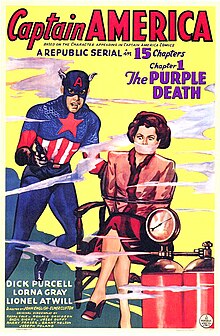
Flash Gordon's Trip to Mars is a 1938 Universal Pictures 15–chapter science-fiction movie serial based on the syndicated newspaper comic strip Flash Gordon. It is the second of the three Flash Gordon serials made by Universal between 1936 and 1940. The main cast from the first serial reprise their roles: Buster Crabbe as Flash Gordon, Jean Rogers as Dale Arden, Frank Shannon as Dr. Alexis Zarkov, Charles B. Middleton as Ming the Merciless, and Richard Alexander as Prince Barin. Also in the principal cast are Beatrice Roberts as Queen Azura, Donald Kerr as Happy Hapgood, Montague Shaw as the Clay King, and Wheeler Oakman as Ming's chief henchman. The serial was followed by Flash Gordon Conquers the Universe (1940).
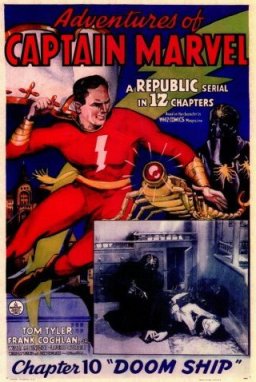
Adventures of Captain Marvel is a 1941 American 12-chapter black-and-white movie serial from Republic Pictures, produced by Hiram S. Brown, Jr., directed by John English and William Witney, that stars Tom Tyler in the title role of Captain Marvel and Frank Coghlan, Jr. as his alter ego, Billy Batson. The serial was adapted from the popular Captain Marvel comic book character, then appearing in the Fawcett Comics publications Whiz Comics and Captain Marvel Adventures. The character is now owned by DC Comics and is known as Shazam.

The Masked Marvel (1943) is a 12-chapter film serial created by Republic Pictures, who produced many other well known serials. It was Republic's thirty-first serial, of the sixty-six they produced.

Zombies of the Stratosphere is a 1952 colorless Republic Studios serial directed by Fred C. Brannon, with a screenplay by Ronald Davidson, and special effects by Republic's Lydecker brothers. It was intended to be Republic's second serial featuring "new hero" Commando Cody and the third 12-chapter serial featuring the rocket-powered flying jacket and helmet introduced in King of the Rocket Men (1949). Instead, for reasons unknown, the hero was renamed "Larry Martin", who must prevent Martian invaders from using a hydrogen bomb to blow Earth out of its orbit, so that the Martians can move a dying Mars into a much closer orbital position to the Sun. As in Radar Men from the Moon, much of the screen time for each of the dozen chapters is spent on fistfights and car chases between the heroes and a gang of earthly crooks hired by renegade scientist Dr. Harding and his extraterrestrial colleague Marex to steal and stockpile the Atomic supplies needed for construction of the H-bomb.

Captain Video: Master of the Stratosphere is an American adventure horror science fiction film 15-chapter serial released by Columbia Pictures in 1951. It was directed by Spencer Gordon Bennet and Wallace A. Grissel with a screenplay by Royal G. Cole, Sherman I. Lowe and Joseph F. Poland, based on a treatment by George H. Plympton. The serial is unique for several reasons--- in particular, it is the only film serial ever based on a television program, Captain Video and His Video Rangers.
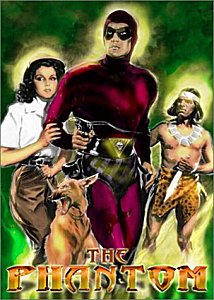
The Phantom is a 1943 15-chapter cliffhanger superhero serial, produced by Rudolph C. Flothow, directed B. Reeves Eason, and starring Tom Tyler in the title role. It is based on Lee Falk's comic strip The Phantom, first syndicated to newspapers in 1936 by King Features Syndicate. The serial also features Jeanne Bates as the Phantom's girlfriend Diana Palmer, and Ace the Wonder Dog as the Phantom's trusty German shepherd Devil.

Ace Drummond is a Universal Pictures 1936 film serial based on the comic strip "Ace Drummond" written by Captain Eddie Rickenbacker and drawn by Clayton Knight. The serial's cast features John King, Jean Rogers, Noah Beery Jr. and Jackie Morrow, with Lon Chaney Jr. in a supporting role.

Mysterious Doctor Satan is a 1940 American film serial directed by William Witney and John English. Produced by Republic Pictures, the serial stars Edward Ciannelli, Robert Wilcox, William Newell, C. Montague Shaw, Ella Neal, and Dorothy Herbert. The title of the serial is derived from that of its chief villain.
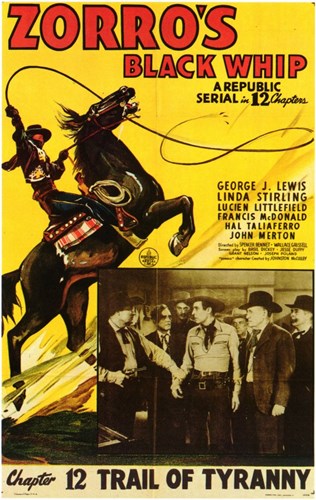
Zorro's Black Whip is a 1944 12-chapter film serial by Republic Pictures starring Linda Stirling. The film was made after the 1940 20th Century-Fox remake of The Mark of Zorro in order to capitalize on it. Republic was not able to use the character of Zorro himself, however, and despite the title, the hero(ine) is called The Black Whip throughout.
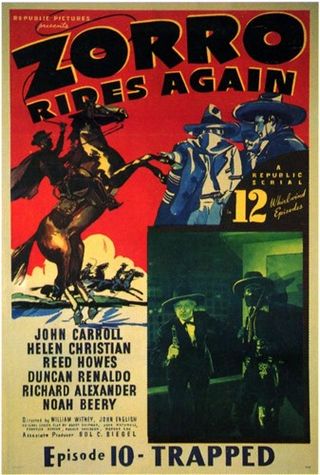
Zorro Rides Again (1937) is a 12-chapter Republic Pictures film serial. It was the eighth of the sixty-six Republic serials, the third with a Western theme and the last produced in 1937. The serial was directed by William Witney & John English in their first collaboration. The serial starred John Carroll who also sang the title song as a modern descendant of the original Zorro with Carroll stunt doubled by Yakima Canutt. The plot is a fairly standard western storyline about a villain attempting to illicitly take valuable land. The setting is a hybrid of modern (1930s) and western elements that was used occasionally in B-Westerns. It was also the first in a series of five Zorro serials, followed by Zorro's Fighting Legion (1939), Zorro's Black Whip (1944), Son of Zorro (1947) and Ghost of Zorro (1949).
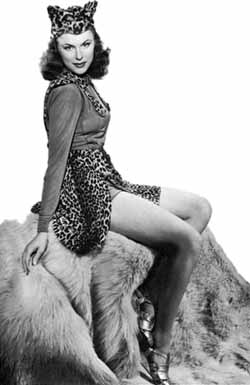
The Tiger Woman (1944) is a 12-chapter film serial by Republic Pictures starring Allan Lane and Linda Stirling. The serial was re-released in 1951 under the title Perils of the Darkest Jungle and, in 1966, it was edited into the 100-minute Century-66 film Jungle Gold.

Jungle Girl is a 1941 15-chapter Republic serial starring Frances Gifford. It was directed by William Witney and John English based on the novel Jungle Girl (1932) by Edgar Rice Burroughs. It was the 22nd of the 66 serials produced by Republic.
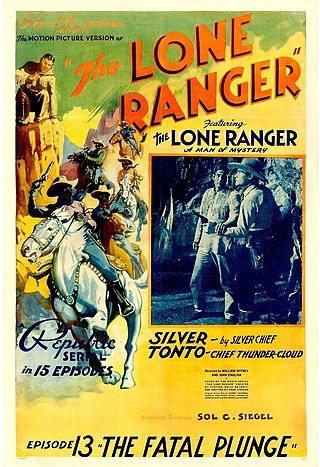
The Lone Ranger is a 1938 American Republic Pictures movie serial based on The Lone Ranger radio program. It was the ninth of the sixty-six serials produced by Republic, the fourth Western and the first Republic serial release of 1938. The following year a sequel serial The Lone Ranger Rides Again was released. The fifteen chapters of the serial were condensed into the film Hi-Yo Silver, which was released in 1940.
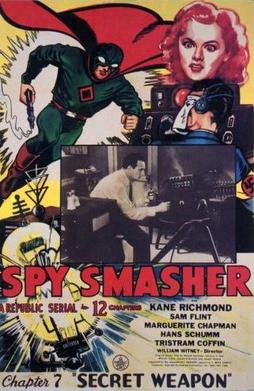
Spy Smasher is a 12-episode 1942 Republic serial film based on the Fawcett Comics character Spy Smasher which is now a part of DC Comics. It was the 25th of the 66 serials produced by Republic. The serial was directed by William Witney with Kane Richmond and Marguerite Chapman as the leads. The serial was Chapman's big break into a career in film and television. Spy Smasher is a very highly regarded serial. In 1966, a television film was made from the serial footage under the title Spy Smasher Returns.
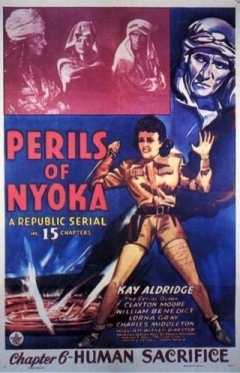
Perils of Nyoka is a 1942 Republic serial directed by William Witney. It stars Kay Aldridge as Nyoka the Jungle Girl, a character who first appeared in the Edgar Rice Burroughs-inspired serial Jungle Girl.
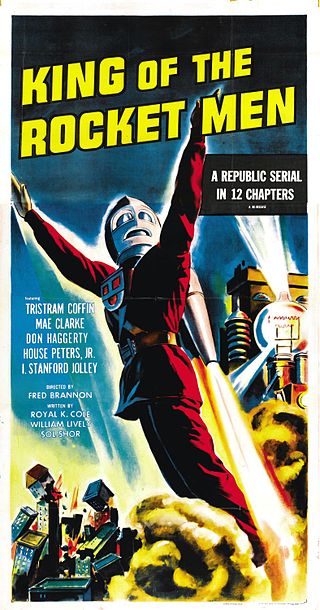
King of the Rocket Men is a 1949 12-chapter movie serial from Republic Pictures, produced by Franklin Adreon, directed Fred C. Brannon, that stars Tristram Coffin, Mae Clarke, Don Haggerty, House Peters, Jr., James Craven, and I. Stanford Jolley.
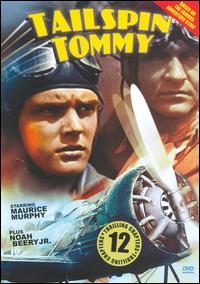
Tailspin Tommy is a 12-episode 1934 Universal film serial based on the Tailspin Tommy comic strip by Hal Forrest. Directed by Lew Landers and produced by Milton Gatzert, the serial was the 97th serial of the 137 released by that studio. The plot of Tailspin Tommy concerns a conflict over a government airmail contract.

Richard Gerold Purcell Jr. was an American actor best known for playing Marvel Comics' Captain America in the 1944 film serial, co-starring with Lorna Gray and Lionel Atwill. Purcell also appeared in films such as Tough Kid (1938), Accidents Will Happen (1938), Heroes in Blue (1939), Irish Luck (1939), The Bank Dick (1940), and King of the Zombies (1941).
Mr. Scarlet and Pinky the Whiz Kid are two duo fictional comic book superheroes connected to each other, and first introduced in Wow Comics. The superheroes were originally published by Fawcett Comics and later by DC Comics. The original Mister Scarlet was Brian Butler debuting in Wow Comics #1, and was created by France Herron and Jack Kirby while Pinky Butler became his sidekick, Pinky the Whiz Kid. After Brian's death, Pinky takes over the role as Mr. Scarlet in DC's continuity. Pinky Butler premiered in the fourth issue of Wow Comics.
